
Macaronesia is a collection of four volcanic archipelagos in the North Atlantic Ocean, off the coasts of the continents of Africa and Europe. Each archipelago is made up of a number of Atlantic oceanic islands, which are formed by seamounts on the ocean floor that have peaks above the ocean's surface. Some of the Macaronesian islands belong to Portugal, some belong to Spain, and the rest belong to Cape Verde. Politically, the islands belonging to Portugal and Spain are part of the European Union. Geologically, Macaronesia is part of the African tectonic plate. Some of its islands – the Azores – are situated along the edge of that plate at the point where it abuts the Eurasian and North American plates.
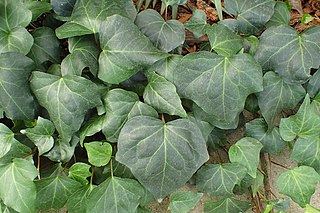
Hedera, commonly called ivy, is a genus of 12–15 species of evergreen climbing or ground-creeping woody plants in the family Araliaceae, native to western, central and southern Europe, Macaronesia, northwestern Africa and across central-southern Asia east to Japan and Taiwan.

Pinus canariensis, the Canary Island pine, is a species of gymnosperm in the conifer family Pinaceae. It is a large, evergreen tree native and endemic to the outer Canary Islands in the Atlantic Ocean. It is a subtropical pine and does not tolerate low temperatures or hard frost, surviving temperatures down to about −6 to −10 °C. Within its natural area, it grows under extremely variable rainfall regimes, from less than 300 mm (12 in) to several thousands, mostly due to differences in mist-capturing by the foliage. Under warm conditions, this is one of the most drought-tolerant pines, living even with less than 200 mm (7.9 in) of rainfall per year. It is the vegetable symbol of the island of La Palma.

Laurel forest, also called laurisilva or laurissilva, is a type of subtropical forest found in areas with high humidity and relatively stable, mild temperatures. The forest is characterized by broadleaf tree species with evergreen, glossy and elongated leaves, known as "laurophyll" or "lauroid". Plants from the laurel family (Lauraceae) may or may not be present, depending on the location.

Hedera hibernica, common name Atlantic ivy, Boston Ivy or Irish ivy, is a woody vine native to the Atlantic coast of Europe.

Hedera helix, the common ivy, English ivy, European ivy, or just ivy, is a species of flowering plant of the ivy genus in the family Araliaceae, native to most of Europe and western Asia. A rampant, clinging evergreen vine, it is a familiar sight in gardens, waste spaces, and wild areas, where it grows on walls, fences, tree trunks, etc. across its native and introduced habitats. As a result of its hardy nature, and its tendency to grow readily without human assistance, ivy attained popularity as an ornamental plant, but escaped plants have become naturalised outside its native range and grow unchecked in myriad wild and cultivated areas.
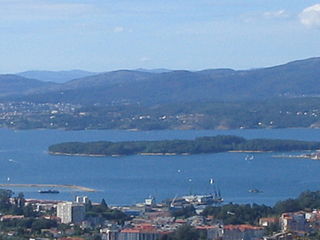
Cortegada is an almost tidal island in a coastal inlet near Pontevedra in Galicia, Spain. It is part of the Atlantic Islands of Galicia National Park.

Ilex canariensis, the small-leaved holly, is an endemic species of holly native to Macaronesian islands. It is a species of plant in the family Aquifoliaceae. It is found in the Macaronesian islands of Madeira (Portugal) and Canary Islands (Spain).
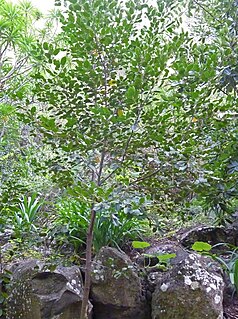
Rhamnus glandulosa is a species of plant in the family Rhamnaceae. It is endemic to Madeira and the Canary Islands.
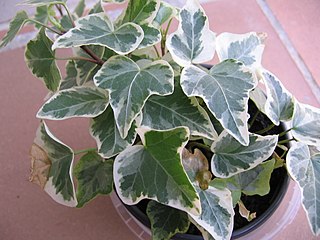
Hedera algeriensis, the Algerian ivy, is a species of evergreen ivy native to the North African coast, including coastal mountains in Algeria.
Hedera maderensis, the Madeiran ivy, is a species of ivy which is native to the Atlantic coast in Madeira island. It is a plant of botanical family Araliaceae, species endemic to the island of Madeira with the name: Hedera maderensis. Formerly a subspecies named Hedera maderensis iberica, one iberian subspecies in west Iberian peninsula was subsequently classified as a distinct species. It is quite common in Madeira and lives in slopes rock, soil, trunks of trees especially in Laurel forest of Barbusano.

Hedera maroccana, the Moroccan ivy, is a species of ivy which is native to the Atlantic coast in northern Africa. It is an evergreen climbing plant, growing to 20–30 m high where suitable surfaces are available, and also growing as ground cover where there are no vertical surfaces. It climbs by means of aerial rootlets which cling to the substrate. In warm climates, it grows more rapidly and becomes established a good bit faster than the related Hedera hibernica and Hedera helix.

Hedera colchica is a species of ivy which is native to Near and Middle East. It is commonly called Persian ivy or colchis ivy. It is an evergreen climbing plant, growing to 30 m high where suitable surfaces are available, and also growing as ground cover where there are no vertical surfaces. It climbs by means of aerial rootlets which cling to the substrate. In warm climates, it grows more rapidly and becomes established faster than other Hedera species.

Hedera iberica is a species of ivy which is native to the western Iberian peninsula, and northern Morocco. It was formerly classified as a sub-species named Hedera maderensis iberica in Hedera maderensis. The Iberian subspecies was subsequently classified as a distinct species. It grows on slopes, rock, soil, trunks of trees.

Hedera azorica, the Azores ivy, is a species of ivy which is native to the Atlantic coast in the Azores Islands. It is an evergreen climbing plant, growing to 20–30 m high where suitable surfaces are available, and grows as ground cover where there are no vertical surfaces. It climbs by means of aerial rootlets which cling to the substrate.
Hedera cypria, is a species of Ivy which is endemic to the island of Cyprus. It is an evergreen climbing plant, growing slowly to 20–30 m high where suitable surfaces are available, and also growing as ground cover where there are no vertical surfaces. It climbs by means of aerial rootlets which cling to the substrate. It is more common at higher altitudes in rocky, shadowy riverine forest, over 400–650 m. In its natural habitat it can be distinguished easily from Hedera helix subsp. poetarum, also present, because the latter has yellow fruits, while Hedera cypria is always black-fruited.
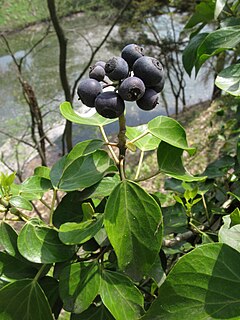
Hedera rhombea, the Japanese ivy or songak, is a species of ivy in the Araliaceae family native to East Asia. Formerly named Hedera pedunculata, some subspecies could be subsequently classified as a distinct species. It is common on rocky slopes and growing up the trunks of trees, especially in laurel forest, a type of cloud forest.
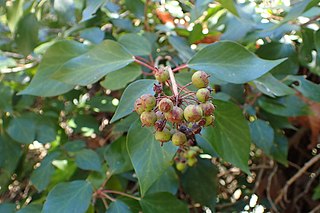
Hedera pastuchovii, (Araliaceae) is a species of ivy native to eastern Transcaucasia and listed in The Red Book of the Azerbaijan SSR, 1989.
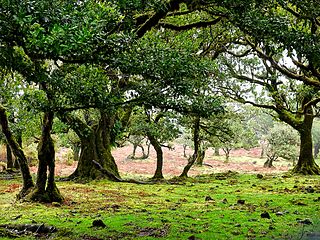
The Madeira evergreen forests is a laurissilva ecoregion of southwestern Europe. It covers the archipelago of Madeira and some nearby islands in the Atlantic Ocean. Laurel forest, known as laurissilva, once covered the islands. Over centuries the laurel forests were mostly cleared. Madeira's remaining forests are now protected.
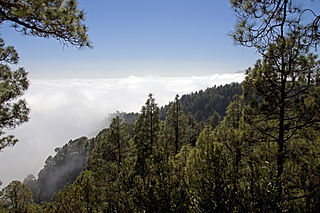
The Canary Islands dry woodlands and forests is a Mediterranean forests, woodlands, and scrub ecoregion in the Canary Islands. It encompasses the western group of the Canary Islands – La Palma, El Hierro, La Gomera, Tenerife, and Gran Canaria – in the Atlantic Ocean. These volcanic islands are an autonomous community of Spain, and lie southwest of the Spanish mainland and west of the North African coast.



















